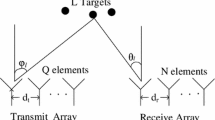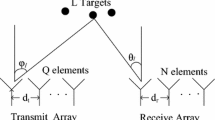Abstract
Passive bistatic coherent radar system operates with distinct non-cooperative transmitter and receiver located at different sites. In such spatial separation, the receiving system needs to independently solve the problem of time and phase synchronization via direct-path signal. The impact of time synchronization error was explored and solved in passive bistatic coherent radar. The common model of digital sampling process is introduced to illustrate the effect of time synchronization error (TSE). The periodicity of relative sample instant variation of each pulse is deduced. Then, normalized interference power (NIP) is defined to evaluate the potential impact of TSE. The NIP expressions are derived when the difference between the adjacent relative sample instant is uniform distribution or Gaussian distribution. It is found that there are new spurious frequency components and the detection performance is decreased in the case of asynchronous sampling. At the same time, the analytical Doppler frequency bias expression caused by TSE is presented. Theoretical results are confirmed by simulation in the cases of different periods of relative sampling instant.
Similar content being viewed by others

References
Qi R, Coakley F P, Evans B G. Practical consideration for band-pass sampling. IEE Electr Lett, 1996, 32: 1861–1862
Ma B T, Fan H Q, Fu Q. IF sampling conditions for coherent pulse radar (in Chinese). J Data Acquis Process, 2009, 24: 114–118
Zhu Y L, Fan H Q, Ma B T, et al. Design of IF signal acquisition system for pulse coherent radars (in Chinese). Syst Eng Electr, 2009, 31: 489–496
Wang X M, Kuang Y S, Chen Z X. Surveillance Radar Technology (in Chinese). Beijing: Publishing House of Electronics Industry. 2008. 366–369
Thomas D D. Synchronization of noncooperative bistatic radar receivers. PhD Dissertation. Syracuse University, 1999
Yang Z Q, Zhang Y S, Luo Y J. Bistatic/Multistatic Radar System (in Chinese). Beijing: Publishing House of National Defense Industry, 1998. 209–214
Wang W Q, Ding C B, Liang X D. Time and phase synchronization via direct-path signal for bistatic synthetic aperture radar systems. IET Radar Sonar Navig, 2008, 2: 1–11
Jenq Y C. Digital spectra of non-uniformly sampled signals: fundamentals and high-speed waveform digitizers. IEEE Trans Instrum Measur, 1988, 37: 245–251
Jenq Y C. Digital spectra of non-uniformly sampled signalsdigital look-up tunable sinusoidal oscillators. IEEE Trans Instrum Measur, 1988, 37: 358–362
Tarczynski A, Valimaki V, Cain G D. FIR filtering of non-uniformly sampled signals. In: IEEE Inter Con ASSP, New Paltz, NY, USA, 1997. 2237–2240
Jenq Y C. Perfect reconstruction of digital spectrum from non-uniformly sampled signals. In: IEEE Instrumentation and Measurement Technology Conference, Ottawa, Canada, 1997. 19–21
Tao WW, Zhang J Q, Lu Q Y. Spectral interpolated compensation analysis of non-coherent sampling signals (in Chinese). J Fudan Univ (Nat Sci), 2008, 47: 703–709
Geng X P, Hu Y H, Yan H H, et al. An improved imaging algorithm for fixed-receiver bistatic SAR. Sci China Inf Sci, 2010, 53: 1461–1469
Hang L, Jing W, Xing M D, et al. Unparallel trajectory bistatic spotlight SAR imaging. Sci China Ser F-Inf Sci, 2009, 52: 91–99
Kulpa K S, Czekala Z. Masking effect and its removal in PCL radar. IEE Radar Sonar Nav, 2005, 152: 174–178
Griffiths H D, Baker C J. Passive coherent location radar systems Part 1: performance prediction. IEE Radar Sonar Nav, 2005, 152: 153–159
Howland P E, Maksimiuk D, Reitsma G. FM radio based bistatic radar. IEE Radar Sonar Nav, 2005, 152: 107–115
Choi Y S, Voltz P J, Casara F A. On channel estimation and detection for multicarrier signals in fast and selective Rayleigh fading channels. IEEE Trans Commun, 2001, 49: 1375–1387
Lu D J. Stochastic Process with Application (in Chinese). Beijing: Publishing House of Tsinghua Univ., 2007. 661–662
Author information
Authors and Affiliations
Rights and permissions
About this article
Cite this article
He, Y., Zhang, C., Ding, J. et al. The impact of time synchronization error on passive coherent pulsed radar system. Sci. China Inf. Sci. 53, 2664–2674 (2010). https://doi.org/10.1007/s11432-010-4110-x
Received:
Accepted:
Published:
Issue Date:
DOI: https://doi.org/10.1007/s11432-010-4110-x



